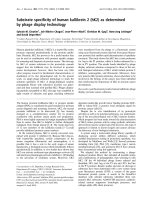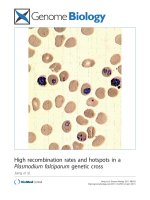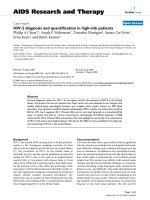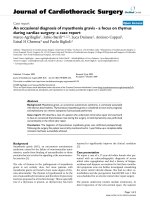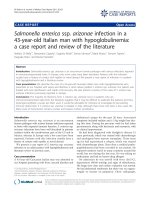Báo cáo y học: "False positive diagnosis of malignancy in a case of cryptogenic organising pneumonia presenting as a pulmonary mass with mediastinal nodes detected on fluorodeoxyglucose-positron emission tomography: a case report" ppsx
Bạn đang xem bản rút gọn của tài liệu. Xem và tải ngay bản đầy đủ của tài liệu tại đây (385.51 KB, 4 trang )
BioMed Central
Page 1 of 4
(page number not for citation purposes)
Journal of Medical Case Reports
Open Access
Case report
False positive diagnosis of malignancy in a case of cryptogenic
organising pneumonia presenting as a pulmonary mass with
mediastinal nodes detected on fluorodeoxyglucose-positron
emission tomography: a case report
Aravind Ponnuswamy
1
, Neeraj Mediratta
2
, Iain D Lyburn
3
and
James P Finnerty*
4
Address:
1
Countess of Chester Hospital NHS Foundation Trust, Chester, Cheshire, CH2 1UL, UK,
2
Cardiothoracic Centre, Broadgreen Hospital,
Liverpool, L14 3LB, UK,
3
The PETCT Department, The Cheltenham Imaging Centre, Cheltenham, Gloucestershire, GL53 7AS, UK and
4
Countess
of Chester Hospital, Liverpool Road, Chester, Cheshire, CH2 1UL, UK
Email: Aravind Ponnuswamy - ; Neeraj Mediratta - ;
Iain D Lyburn - ; James P Finnerty* -
* Corresponding author
Abstract
Introduction: We report the case of a patient with positive findings on a lung emission
tomography/computed tomography (PET/CT) scan, with possible contra lateral mediastinal
involvement, which strongly suggested an inoperable lung carcinoma. The lung mass proved to be
a cryptogenic organising pneumonia. While the latter has previously been shown to be PET/CT
positive, mediastinal involvement simulating malignant spread has not been previously reported.
Case presentation: A 50-year-old Caucasian woman presented with a history of unproductive
cough and was found to have a mass in the right upper lobe as shown on chest X-ray and a
computed tomography scan. A subsequent PET/CT scan showed strong uptake in the right upper
lobe (maximum standard uptake values (SUVmax) 9.6) with increased uptake in the adjacent
mediastinum and contralateral mediastinal nodes. Surgical resection and mediastinoscopy revealed
cryptogenic organising pneumonia, with enlarged reactive mediastinal lymph nodes.
Conclusion: The case illustrates the limits of PET/CT scanning as a diagnostic tool, and emphasizes
the importance of obtaining histological confirmation of malignant diseases whenever possible.
Introduction
Fluorodeoxyglucose (FDG)-positron emission tomogra-
phy (PET) has an established role in diagnosing and stag-
ing malignant focal lesions and has been shown to be
superior to chest computed tomography (CT) scans in
assessing mediastinal involvement and distant metastases
[1]. However, FDG uptake is not specific for cancer, and
many reports of positive PET scans in other diseases have
been published. Mycobacterial, fungal, and bacterial
infections, sarcoidosis, and radiation pneumonitis have
shown intense uptake on PET scan. However, tumours
with low glycolytic activity such as adenomas, bronchi-
oloalveolar carcinomas, carcinoid tumours, low grade
lymphomas and sub centimeter tumour masses have
revealed false negative findings on PET scans.
Published: 14 November 2009
Journal of Medical Case Reports 2009, 3:124 doi:10.1186/1752-1947-3-124
Received: 26 August 2008
Accepted: 14 November 2009
This article is available from: />© 2009 Ponnuswamy et al; licensee BioMed Central Ltd.
This is an Open Access article distributed under the terms of the Creative Commons Attribution License ( />),
which permits unrestricted use, distribution, and reproduction in any medium, provided the original work is properly cited.
Journal of Medical Case Reports 2009, 3:124 />Page 2 of 4
(page number not for citation purposes)
We present a case of a patient with a positive FDG-PET
scan that was consistent with lung cancer with metastases
to mediastinal nodes. The patient underwent mediasti-
noscopy and thoracotomy and the histological diagnosis
after the operation was a cryptogenic organising pneumo-
nia.
Case presentation
A 50-year-old Caucasian woman presented to a chest
clinic with a 1-year history of a cough. A chest X-ray per-
formed at the time of onset of symptoms had been nor-
mal. She had a history of allergic rhinitis and had
developed a wheeze, and a provisional diagnosis of aller-
gic asthma was made by her family doctor. There was an
initial improvement in her symptoms with courses of
prednisolone, but by the third course she was failing to
respond. She had also been given a month's trial of a pro-
ton pump inhibitor for suspected associated acid reflux.
There were no complaints of loss of weight or appetite.
She had smoked 20 cigarettes daily from her youth until
10 years prior to presentation.
On examination, her vital signs were normal and chest
examination was clear. Spirometry revealed a forced expir-
atory volume in 1 second (FEV1) of 2.14 litre (100% pre-
dicted) and a forced vital capacity (FVC) of 2.65 litre (93%
predicted). A chest X-ray was performed which showed ill-
defined shadowing in the right upper zone. The patient
subsequently developed pain over the right shoulder. A
CT scan revealed a 6 × 3 cm mass in the right lung apex
extending alongside the right side of the mediastinum to
a level above the right hilum. A provisional diagnosis of
lung cancer was made. Her case was reviewed at the lung
cancer multidisciplinary team meeting and further inves-
tigations were arranged: a half body FDG-PET/CT scan, a
right anterior mediastinotomy and bronchoscopy. Bron-
choscopy findings were normal, and cytological analysis
of a transcarinal aspiration showed a small number of
lymphocytes and macrophages. Similarly, the biopsies
from the mediastinotomy showed reactive lymph node
tissue only.
The FDG-PET/CT scan showed multifocal, ill-defined
semi confluent areas of marked increased uptake (maxi-
mum standard uptake values (SUVmax) of up to 9.6)
within areas of dense consolidation in the right lung
upper lobe (Figure 1). Focal intense uptake was present in
right hilar precarinal and right and left paratracheal nodes
(Figure 2). There was no abnormal uptake outside the tho-
rax. These findings were consistent with a T4, N3 and M0
bronchial carcinoma.
Blood tests revealed eosinophilia with very high immu-
noglobulin E (IgE) of 1304 kAU/L (normal <87). A posi-
tive radioallergosorbent test (RAST) revealed Aspergillus
fumigates, and Aspergillus precipitins were moderately pos-
itive, with a titre of 1 in 8. The eosinophil count was ele-
vated at 0.48 × 10
9
/litre, which was 4.9% of the white cell
count. The erythrocyte sedimentation rate was elevated at
64 mm/hr.
Following a multidisciplinary meeting to discuss the
patient, the decision was made to proceed with surgery.
Repeat bronchoscopy showed inflammation of the right
main bronchus and segmental bronchi. A right posterola-
teral thoracotomy was performed. Adhesions were noted
between the apex of the right upper lobe and the parietal
pleura as well as the mediastinal pleura. Two poorly
Coronal series showing dense consolidation with areas of increased uptake in the right upper lobe: CT, positron emis-sion tomography and fused PET/CT imagesFigure 1
Coronal series showing dense consolidation with
areas of increased uptake in the right upper lobe: CT,
positron emission tomography and fused PET/CT
images.
Journal of Medical Case Reports 2009, 3:124 />Page 3 of 4
(page number not for citation purposes)
delimited tumours were evident in the right upper lobe,
one towards the apex and the other in the region of the
transverse fissure between the upper and middle lobes.
Enlargement of the paratracheal, para-oesophageal and
hilar nodes was noted. Biopsies were taken from the right
upper lobe, paratracheal nodes, para-oesophageal nodes
and hilar nodes. All showed reactive changes only on the
frozen section. Following discussion with our oncologist
in the operating theatre, and given the possibility that
there was an occult neoplasm at the centre of one or both
of the upper lobe masses, the upper and middle lobes
were resected.
A histological examination revealed a poorly defined, tan-
coloured mass, 65 mm in diameter, in the upper lobe. A
microscopic examination of this mass showed organising
pneumonia, with numerous macrophages and giant cells.
There was no evidence of necrosis or the formation of
granulomata. There was an overlying pleurisy, in which
giant cells were seen. All the lymph nodes examined
showed reactive changes only. Further examination and
staining for Aspergillus did not reveal any fungi in the sam-
ples.
Two months after surgery, the patient was clinically well.
In view of the positive Aspergillus precipitins and elevated
IgE and the cryptogenic organising pneumonia on the his-
tology, she was put on both prednisolone and itracona-
zole. She has had no recurrence of her respiratory
symptoms since her surgery. She is currently not under
therapy, with normal inflammatory markers and no evi-
dence of consolidation on her chest X-ray 18 months after
surgery.
Discussion
There are significant limitations of the predictive value of
positive PET scans, both in establishing mediastinal inva-
sion in proven primary lung cancer and in establishing a
diagnosis of lung cancer where histological proof has not
been obtained. Recent guidelines on non-invasive staging
of proven lung cancer gave pooled sensitivity and specifi-
city for CT scanning and PET scanning in identifying
mediastinal metastases [1]. For CT scanning, the sensitiv-
ity was 51% (95% CI: 47-54%) and specificity 85% (95%
CI: 84-88%), whereas for PET/CT, the sensitivity was 74%
(95% CI: 69-79%) and specificity was 85% (95% CI 82-
88%). The authors emphasised that "with either test,
abnormal findings must be confirmed by tissue biopsy to
ensure accurate staging". A recent study looked at 100
patients whose early lung cancer was confirmed by
pathology. The study found seven patients who had a false
positive PET evaluation of mediastinal metastases [2],
while the sensitivity for detecting involved mediastinal
nodes was 87.5%. Most of the false positive results were
associated with a concurrent inflammatory process. A fur-
ther retrospective study of 54 patients with non-small cell
lung cancer undergoing pre-operative assessment showed
that for the diagnosis of mediastinal malignancy in 306
lymph nodes resected, the sensitivity of PET was 73%, and
the positive predictive value of PET, that is, the percentage
of truly positive nodes in those reported as positive by
PET, was 70%.
High FDG uptake values tend to correlate with a greater
probability of malignancy. In a multivariate analysis [3]
including pathologic tumour size, involved nodes, histol-
ogy, and SUVmax, only tumour size (T) of more than 3 cm
and SUVmax of more than 9 and their interaction were
significant predictors of survival (P = 0.01, 0.02, and
<0.01, respectively). The 3-year survival for patients with
both T <3 cm and SUVmax <9 was 97%; for those with T
<3 cm and SUVmax >9, it was 94%; for those with T >3 cm
and SUVmax <9, it was 93%; and for those with T >3 cm
and SUVmax of >9, it was 47% (P < 0.01). The SUVmax of
9.6 in the lung lesion in this patient illustrates that non-
malignant inflammatory lesions may have very high
uptake values.
Axial series showing dense consolidation with areas of increased uptake in the right upper lobe and focal uptake in a contralateral mediastinal node: CT, positron emission tom-ography and fused PET/CT imagesFigure 2
Axial series showing dense consolidation with areas
of increased uptake in the right upper lobe and focal
uptake in a contralateral mediastinal node: CT, posi-
tron emission tomography and fused PET/CT
images.
Publish with BioMed Central and every
scientist can read your work free of charge
"BioMed Central will be the most significant development for
disseminating the results of biomedical research in our lifetime."
Sir Paul Nurse, Cancer Research UK
Your research papers will be:
available free of charge to the entire biomedical community
peer reviewed and published immediately upon acceptance
cited in PubMed and archived on PubMed Central
yours — you keep the copyright
Submit your manuscript here:
/>BioMedcentral
Journal of Medical Case Reports 2009, 3:124 />Page 4 of 4
(page number not for citation purposes)
Cryptogenic organising pneumonia (sometimes known as
BOOP) is well known to present, occasionally, as a soli-
tary lesion, usually in the upper lobes and sometimes with
cavitation; it is one of the mimics of lung cancer [4].
Amongst the variety of benign thoracic conditions that
can demonstrate hypermetabolism on FDG-PET scans,
crytogenic organising pneumonia (COP) has been
reported as giving a positive FDG-PET scan in a case report
[5]. COP is not commonly associated with significant
enlargement of mediastinal lymph nodes: a recent study
showed detectable enlargement in six out of 16 patients
with COP [6]; and it is not usually associated with chest
pain or pleurisy [4]. In our patient, the physical enlarge-
ment and hypermetabolism of both ipsilateral and con-
tralateral mediastinal nodes were very unusual for COP,
and led to lung resection despite the findings of only reac-
tive changes on the frozen section.
The findings of asthma, high IgE, raised circulating eosi-
nophils, and positive RAST and precipitin tests for
Aspergillus fumigatus raised the possibility of allergic bron-
chopulmonary aspergillosis (ABPA). No evidence of fun-
gal colonisation was found in the resected lung. Although
COP has been associated with a variety of infections
including fungal infections, we are not aware of any asso-
ciation with ABPA. The decision to treat the patient with a
protracted course of itraconazole was made on the specu-
lative grounds that fungal sensitisation may have contrib-
uted to the development of COP; however, this was not
based on evidence.
Conclusion
Our case illustrates that COP can not only simulate a lung
tumour, but can also simulate inoperable lung cancer
with extensive mediastinal involvement and exhibit very
marked uptake on FDG-PET. It serves to reinforce the
importance of obtaining a histological diagnosis of lung
masses wherever possible.
Consent
Written informed consent was obtained from the patient
for publication of this case report and any accompanying
images. A copy of the written consent is available for
review by the Editor-in-Chief of this journal.
Competing interests
The authors declare that they have no competing interests.
Authors' contributions
All the authors contributed to the writing of the paper.
The original manuscript was written by AP, and the final
version by JPF. IDL contributed the PET/CT images and
additional references.
References
1. Silvestri GA, Gould MK, Margolis ML, Tanoue LT, McCrory D, Toloza
E, Detterbeck F: Non-invasive staging of non-small cell lung
cancer: ACCP evidence-based clinical practice guidelines.
Chest 2nd edition. 2007, 132:178S-201S.
2. Roberts PF, Follette DM, von Haag D, Park JA, Valk PE, Pounds TR,
Hopkins DM: Factors associated with false-positive staging of
lung cancer by positron emission tomography. Ann Thorac Surg
2000, 70:1154-1159.
3. Downey RJ, Akhurst T, Gonen M, Vincent A, Bains MS, Larson S,
Rusch V: Preoperative F-18 fluorodeoxyglucose-positron
emission tomography maximal standardized uptake value
predicts survival after lung cancer resection. J Clinic Oncol
2004, 22(Suppl 16):3255-3260.
4. Cordier JF: Organising pneumonia. Thorax 2000, 55:318-328.
5. Shin L, Katz DS, Yung E: Hypermetabolism on F-18 FDG PET of
multiple pulmonary nodules resulting from bronchiolitis
obliterans organising pneumonia. Clin Nucl Med 2004, 29(Suppl
10):654-656.
6. Althoff Souza C, Muller NL, Lee Kyung Soo, Johkoh T, Mitsuhiro H,
Chong S: Idiopathic interstitial pneumonias: prevalence of
mediastinal lymph node enlargement in 206 patients. Am J
Roentgenology 2006, 186:995-999.
